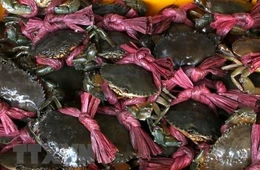Last year, the province planted 506ha of new forests, and replanted 4.2ha of replacement forests and 100ha of special-use forests. It also replanted more than 3,000ha of commercial forests that harvested wood last year.
Ca Mau has more than 94,000ha of concentrated forests, including about 52,000ha of commercial forests, 18,000ha of special-use forests, and 23,000ha of protection forests.
In U Minh Ha forest, the area of high-quality commercial forests totals 22,300ha. The cultivation of forests under intensive growing methods in U Minh Ha has offered farmers a wood output of 150-200 cu.m. per hectare.
Wood is one of five key agricultural products in the province’s agriculture restructuring plan. The other key agricultural products are shrimp, high-quality rice, mud crabs and bananas.
This year, the province’s Department of Agriculture and Rural Development plans to grow 312ha of new forests, aiming to increase the province's coverage rate to 26.2 percent by the end of this year and to 27 percent in 2025.
To meet the coverage rate, the province will plant more than 29 million trees, or 10,892ha of new forests, from now to 2025.
Le Van Su, Vice Chairman of the provincial People’s Committee, has told departments and localities to protect existing forests, especially special–use and protective forests.
Commercial forests
The cultivation of commercial forests has offered a good income for farmers in recent years. Under the instruction of local authorities and forestry companies, farmers have grown acacia trees for wood as the large tree has a high yield and high quality.
In U Minh District’s Khanh Thuan Commune, farmers have used intensive cultivation methods to grow forests and have switched from cajuput to acacia. It takes about five years to harvest acacia trees.
Farmers can earn 100-500 million VND (4,300-21,600 USD) by harvesting wood from one hectare of commercial forest.
Dao Thi Nho in Khanh Thuan’s Hamlet 18 said she moved the hamlet in 1990 and was poor at that time, but she began planting forests in recent years.
“Life is now more comfortable,” she said.
The commune’s average income per capita has increased to 45 million VND (1,940 USD) a year, up 15 percent against 2015.
Besides forests, farmers in the communes grow other short-term crops and animals to improve income, which provides funds while they wait to harvest the wood.
Farmer Nguyen Van Man grows 4ha of commercial forests and 3ha of banana trees in Khanh Thuan’s Hamlet 18. He earns an income of more than 10 million VND (430 USD) a month selling bananas.
Tourism development
With its mangrove forests, national park forests, nature preserves and bird sanctuaries, Ca Mau has rich resources for tourism services, according to the province’s Department of Culture, Sports and Tourism.
Tourists can visit mangrove forests in the Mui Ca Mau National Park, plant trees on alluvial grounds in coastal areas, and visit bird sanctuaries and gardens.
Le Van Hai, head of the province’s Forest Protection Sub-department, said the province has many bird gardens, most of which are owned by households that offer ecotourism services.
Truong Minh Thang, owner of the 10ha Tu Su bird garden in Thoi Binh District’s Bien Bach Dong Commune, began offering tourism services in 2018 with the support of the province’s Department of Culture, Sports and Tourism and the Thoi Binh People’s Committee.
Local authorities have also helped him renovate the garden canals and taught him how to tend to bird species. His garden attracts a large number of visitors each year.
“During the last Tet (Lunar New Year) festival, the number of visitors fell by 60 percent compared to normal because of the impact of the COVID-19 pandemic, but the garden still received about 1,000 visitors,” Thang said.
This year he will build a homestay area separate from the bird garden.
The province has offered support to households that offer homestay services, and has called for more investment in key tourism destinations such as the Ca Mau Cape Tourism Area in Ngoc Hien District.
The province has attracted more than 1.5 million tourists each year to its major tourism destinations since 2018, according to the Department of Culture, Sports and Tourism.
It targets receiving 2.8 million tourists a year by 2030, including 110,000 foreign tourists./.






























